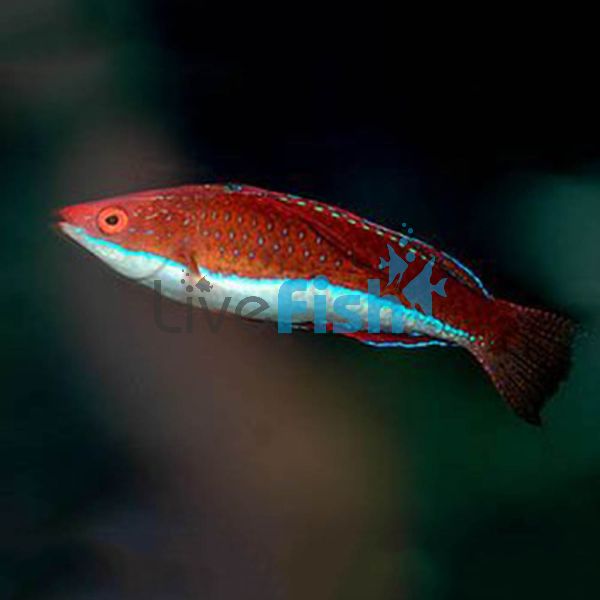Longfin Fairy Wrasse - Medium
The Longfin Fairy Wrasse is a brightly coloured, active fish. It is ideal for a reef tank and one of the best species to keep as a group.
The Longfin Fairy Wrasse varies in colour depending on its mood, habitat, and location. However, it usually has a bright orange/red upper body, paler lower body, and blue tailfin. Its ventral fins are large, rounded, and scarlet in colour. The dorsal and anal fins are also scarlet with blue speckles.
Information is limited about Longfin Fairy Wrasses' breeding habits. It is an egg layer that forms distinct pairs during breeding. Fairy Wrasses are hermaphroditic. The dominant female in a group will change sex to male when required. There are no reports of any sightings of male juveniles.
This species is found in the Red Sea and Western Indian Ocean, from South Africa up to Oman. There are reports of possible sightings in Sri Lanka, Indonesia, and the Philippines. It inhabits reefs over coral and rubble areas. Usually between depths of 3-43 metres.
Tank Recommendations for the Longfin Fairy Wrasse
Recommended tank capacity is at least 50 gallons (189.3 litres).
The Longfin Fairy Wrasse is reef safe and this is its most suitable environment. A tank should have plenty of live rock and hiding places. A sand substrate is great for them to burrow into and sleep. The recommended substrate depth is 2 inches. (5 centimetres).
Wrasses have a reputation for jumping so a secure, tight-fitting cover is recommended.
Suitable Tank Buddies
The Long Fin Fairy Wrasse has a peaceful temperament. It can co-habit with a wide variety of tank mates, as long as the tank has plenty of hiding spaces.
Wrasse can be housed as a group in a reef tank and will mix with other members of the Cirrhilabrus genus.
Usually Compatible
The most suitable tank buddies are peaceful fish. Gobies, Assessors, and other Fairy Wrasses are all great examples. It can also cohabit with small semi-aggressive fish. For example, Dwarf Angelfish, Clownfish, and Anthias.
Sometime Compatible
Conspecifics can be housed together in pairs or as a group. However, a group should consist of a single male and at least four females.
Rarely Compatible
Avoid housing male conspecifics together. Larger Tangs, Angelfish, and Wrassews are unsuitable. Damselfish, Dottybacks may also cause problems. Anything big enough to swallow your Fairy Wrasse should be avoided. Eels and Groupers may fall into this category. Delicate slow movers such as Pipefish and Seahorses will be outcompeted for food.
Feeding your Long Fin Fairy Wrasse
The Long Fin Fairy Wrasse is a carnivore. Its diet requires meaty food such as vitamin-enriched brine shrimp and mysis shrimp. Once acclimatised it should eat a variety of fresh and frozen food as well as food flakes and pellets. Feed several times per day.
| Scientific Name | Cirrhilabrus rubriventralis |
|---|---|
| Care Level | Easy |
| Common Names | Longfin Fairy Wrasse, Social Wrasse, Blue and Red Fairy Wrasse, Dwarf Parrot Wrasse, Redfin Fairy Wrasse, Red Parrot Fairy Wrasse, Small-mouthed Wrasse, Ruby Longfin Fairy Wrasse. |
| Diet | Carnivore |
| Fish Family | Labridae |
| Lifespan (years) | 7 |
| Max. Length (cm) | 8 |
| Min. Tank Volume (l) | 189 |
| Origin | Western Indian Ocean and the Red Sea, from South Africa up to Oman. Possible sightings in Sri Lanka, Indonesia, and the Philippines |
| Reef Safe | Yes |
| Sociability | Peaceful |
| Venomous | No |
| Water Conditions | 22-25° C, dKH 8-12, pH 8.1 -8.4, sg 1.020-1.025 |




